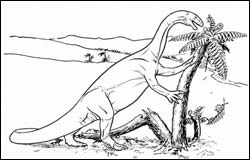Norway’s First Dinosaur discovered – 2256 metres below the seabed

Norway’s first dinosaur fossil is a Plateosaurus, a species that could be up to nine metres long and weigh up to four tons. It lived in Europe and on Greenland 210 to 195 million years ago, at the end of the Triassic Period.
While most nations excavate their skeletons using a toothbrush, the Norwegians found one using a drill.
The somewhat rough uncovering of Norway’s first dinosaur happened in the North Sea, at an entire 2256 metres below the seabed. It had been there for nearly 200 million years, ever since the time the North Sea wasn’t a sea at all, but an enormous alluvial plane.
It is merely a coincidence that the remains of the old dinosaur now see the light of day again, or more precisely, parts of the dinosaur. The fossil is in fact just a crushed knucklebone in a drilling core – a long cylinder of rock drilled out from an exploration well at the Snorre offshore field.
Norway’s first dinosaur fossil is a Plateosaurus, a species that could be up to nine metres long and weigh up to four tons. It lived in Europe and on Greenland 210 to 195 million years ago, at the end of the Triassic Period.
The Plateosaurus at the Snorre offshore field had a hollow grave. The fossil, which was found 2256 metres below the seabed, represents the world’s deepest dinosaur finding. But it is by no means certain that the record-breaking knucklebone is a rarity down there in the abyss.
In fact, the old North Sea land was once a huge area where big rivers meandered through dry plains. Now the landscape has been compressed to form a pattern of fossil alluvial sand between banks of red shale.
Media Contact
More Information:
http://www.nhm.uio.noAll latest news from the category: Earth Sciences
Earth Sciences (also referred to as Geosciences), which deals with basic issues surrounding our planet, plays a vital role in the area of energy and raw materials supply.
Earth Sciences comprises subjects such as geology, geography, geological informatics, paleontology, mineralogy, petrography, crystallography, geophysics, geodesy, glaciology, cartography, photogrammetry, meteorology and seismology, early-warning systems, earthquake research and polar research.
Newest articles

High-energy-density aqueous battery based on halogen multi-electron transfer
Traditional non-aqueous lithium-ion batteries have a high energy density, but their safety is compromised due to the flammable organic electrolytes they utilize. Aqueous batteries use water as the solvent for…

First-ever combined heart pump and pig kidney transplant
…gives new hope to patient with terminal illness. Surgeons at NYU Langone Health performed the first-ever combined mechanical heart pump and gene-edited pig kidney transplant surgery in a 54-year-old woman…

Biophysics: Testing how well biomarkers work
LMU researchers have developed a method to determine how reliably target proteins can be labeled using super-resolution fluorescence microscopy. Modern microscopy techniques make it possible to examine the inner workings…





















